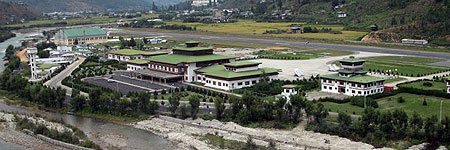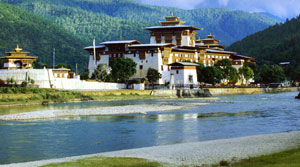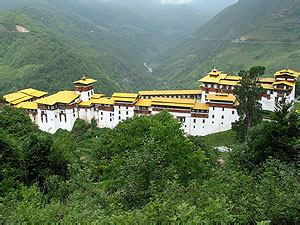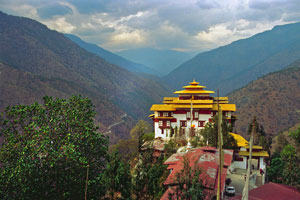|
|
Bhutan Cities |
|
 |
|
|
|
Cities in Bhutan
Bhutan, ‘the Last Shangri-La’ or the ‘Land of the Peaceful
Thunder Dragon’ offers various attractions to tourists from
all around the world. From its stark and striking mountains,
to its lush green forests, fertile valleys, ancient ruins and
culture, Bhutan is a delightful country that holds everybody
in its thrall. The tourist sites and attractions of Bhutan are
a unique experience unlike any other in the world.
Paro
Paro is the gateway to the country of Bhutan. Situated in the
Paro Valley of Eastern Himalaya, the town is full of legends,
heroism, and natural splendour. The town is located at an
altitude of 2,250 m above the sea level with river flowing
gently on its side and making it the most beautiful valley in
the country. Though, the capital of Bhutan is Thimphu, but for
a longer time of the history Paro had the control of this part
of the country. The town of Paro in western Bhutan attracts
tourists due to its scenic locales, beautiful landscapes,
wooded villages and historic buildings. The only airport of
Bhutan is located in Paro.
More.... |
|
|
|
Punakha
Punakha is the winter seat of the Central Monk Body.
Until 1955, Punakha served as the capital of Bhutan. The
Punakha valley is drained by the Phochu and Mochu
rivers. This valley produces rich crops of rice and
fruits, including mangoes, bananas and oranges. Punakha
has a temperate climate. The road from Thimphu to
Punakha is crossed through a 10,218 feet high Dochu La
Pass. This pass offers enchanting views |
 |
|
|
of alpine
snows and red, pink, white, yellow and purple rhododendron
flowers. The Punakha Dzong, Jampe Lhakhang and Kurje monastery
are the main tourist attractions in Punakha. In 1637,
Shabdrung Ngawang Namgyel built the Punakha Dzong (fortress)
at the junction of the Phochu and Mochu rivers to serve as the
religious and administrative centre of Bhutan. Punakha Dzong
houses many sacred temples, including the Machhin Lhakhang,
where the embalmed body of Shabdrung Ngawang Namgyel lies in
state in keeping with tradition. Today, various rituals,
including the serving of meals, is carried out as it was
during the Shabdrung’s life. This dzong was damaged four times
by fire in the late 18th and early 19th centuries and by
earthquakes in 1897. The Punakha Dzong also suffered
devastation by floods. The Dzong was completely restored under
the direction of the present King. The sacred Jampe Lhakhang
and Kurje monasteries are believed to have been built in the
eighth century by Sindhu Raja whom Padmasambhava cured of his
ailment. The body marks of Guru Padmasambhava are still
imprinted on a solid rock.
Thimphu
The capital of Bhutan is Thimphu. Thimphu is situated at a
height of over 7600 feet on a hillside in a fertile valley on
the banks of the Thimphu Chhu River. Thimphu is perhaps the
smallest capital in the world. Thimphu is a gallery of
traditional Bhutanese art, architecture, culture, and
tradition and above all still so ethnic and pure. It is a
fitting and lively place. It is not that modernity has not
reached this region, but they are being introduced in a phased
and balanced manner that is unheard of at any place in the
world. All these make Thimphu a unique destination in Bhutan.
More.... |
|
|
|
Trongsa
Trongsa is situated midway between Ha in the far west
and Tashigang in the far east and is the ancestral home
of Bhutan’s royal family. Lying in the centre of Bhutan,
Trongsa is of great importance in the history of Bhutan.
Trongsa is one of the quaintest and most charming of all
Bhutanese towns. Both Ugyen Wangchuck, the Penlop of
Tongsa who was elected as the nation’s first hereditary
monarch, and his successor King Jigme Wangchuck, ruled
the country from Trongsa's ancient dzong. All four kings
held the post of Tongsa Penlop before being officially
crowned. The present king was |
 |
|
|
appointed as
Penlop in 1972, before his succession to the throne. The main
attraction of Trongsa is the Trongsa Dzong. The Trongsa Dzong
was built by Ngawang Namgyel in 1648 and later enlarged and
decorated. Trongsa Dzong is an awe-inspiring and impregnable
fortress. It has a labyrinth of temples, corridors and offices
holding court over the local community. Due to its strategic
position, the only connecting route between the eastern and
western sectors of the central religion, the Trongsa Penlop
could effectively control the court. This Dzong has a
magnificent collection of rhino-horn sculptures.
Wangdiphodrang
The valley of Wangdiphodrang is situated on the east-west
traverse and road beyond Thimphu, at the junction of the Mochu
and Tangchu rivers. The higher reaches of the valley provide
rich cattle pastures. Yak dairy research station has also been
set up at Gopgona. The Wangdiphodrang Dzong is situated at the
confluence of the Mochu and Tangchu rivers. For many
centuries, it was the seat of one of the Bhutan’s most
powerful dzongpons. |
|
|
|
Tashigang
Tashigang is located in the far eastern part of Bhutan,
on the banks of the Dangme Chhu river. Tashigang is the
hub of the region’s largest and most important district
of Bhutan. Once the centre of a busy trade-route with
Tibet, today, Tashigang is the junction of the east-west
highway with a road which runs north from the foothill
town of Samdrupjongkhar. The local specialities of
Tashigang are the different coloured handloom cloth and
silk, spun from cocoons and bred on castor oil plants.
Tropical crops |
 |
|
|
and fruits
also grows in this area. The Tashigang Dzong, from which the
whole of the eastern region was governed from the late 17th
century until the unification of the country at the beginning
of this century, stands on a steep ridge above the Manas
River. This dzong was built in 1667 by Chogyal Minjur Tempa,
Bhutan’s third Deb. Kelling, the comfortable hotel can be used
as a base for visiting this area.
Mongar
Mongar is situated to the southwest of Tashigang. It is the
second largest settlement in the east. Bhutan’s new dzongs
which were built in 1930 following the traditional
architectural pattern are also located in Mongar. The Kurichu
Hydroelectric project is located in Mongar. When completed, it
will have a total capacity to output 60 megawatts of
hydroelectricity. The town itself is small with a sprinkling
of shops. The Mongar Dzong is modern compared to others in the
kingdom. The Motel Shongar provides accommodation to the
tourists. |
|
|
|
Bumthang
Bumthang is the home of the great Buddhist teacher
Pemalingpa, to whose descendants the present dynasty
traces its ancestry. Pemalingpa was a blacksmith who was
led by mystic forces to discover spiritual treasures at
the bottom of a burning lake. He does not know how to
spread the word contained in the treasures, until one
night the Daklinis or female heavenly spirits revealed
to him the power to preach. On the day when he preached,
flowers dropped from the sky and vanished into rays of
light. |
 |
|
|
Bumthang is
the spiritual heartland of Bhutan, and here the most ancient
and precious Buddhist sites are located. It is the home to the
most important dzongs, temples and palaces. Wangdichholing
Palace, the residence of the former king, Ugyen Wangchuk; the
temple of Jambey Lhakang, the sacred cave of Kurjey Lhakang;
and the largest Bhutanese dzong, Jakar, are all located here.
The Hotel Wangdichhaling provides comfortable stay to the
tourists in Bumthang.
Phobjika
Phobjika is a glacial valley that has been designated a
conservation area. It lies on the borders of the Black
Mountain National Park that is one of the most important
wildlife preserves in Bhutan. The rare, endangered
black-necked cranes that have a special place in Bhutanese
folklore roost here in the winters. Tourists can view their
roosting places with permission from relevant authorities.
Barking deer, wild boars, leopards, Himalayan black bears and
red foxes are some of the animals that live here. The Satkeng
Wildlife Sanctuary is also located nearby. The wild east of
the Bhutanese kingdom can be explored from Punakha, Trashigang,
Wangdue Phodrang and Gangtey Gompa, which are some of the
favorite tourist sites. |
|